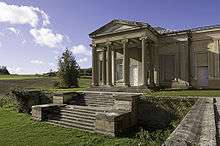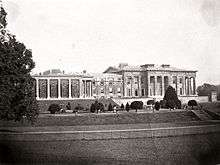The Grange, Northington

The Grange is a 19th-century country house-mansion and English landscape park near Northington in Hampshire, England. It is currently owned by the Ashburton family. English Heritage have a guardianship deed on the Grade I listed building,[1] with the gardens and monument's exterior open to the public.[2] The Grange Park Opera company has staged opera at The Grange every Summer from 1998- to 2016. From June 2017 The Grange Festival will become the new resident opera company.[3]
17th—18th centuries
1662: Robert Henley bought the estate and a modest house known as The Grange. In 1665 he commissioned William Samwell to build an impressive four storey red brick residence to replace the house.
1764: Robert Henley, 1st Earl of Northington (1708–1772) commissioned Robert Adam to design a kitchen block and an entrance bridge. The same year he laid out a naturalistic English landscape park, including a lake and folly.
1787: The second Earl died childless and his sisters sold the house to the Drummond banking family.
1795: The Grange was leased to George, Prince of Wales as a hunting lodge with over 400 deer in the park
19th century
Greek Revival temple

In 1804, Henry Drummond commissioned his friend the architect William Wilkins to transform his brick house into a neoclassical Ancient Greek temple. Wilkins, a promising young architect and antiquary, had been much influenced by his recent travels to Greece and Asia Minor. The massive Doric portico is a copy of the Theseion in Athens and the side elevations imitate the Choragic Monument of Thrasyllus.[4] Whilst commonly claimed to be the earliest Greek Revival style house in Europe, Benjamin Henry Latrobe, for instance, was using the primitive Greek Doric at Hammerwood Park in 1792. The transformation was largely external - the old house was literally wrapped in Roman cement, a very hard render made from ground flint. This is when the podium visible today was built. What had been ground floor rooms became basement rooms and the main reception rooms which had been on the piano nobile were now at the same level as the podium. The windows of servants’ rooms on the uppermost storey were covered by the entablature of the temple facade, and is partly why it was necessary to extend the house. As at Hammerwood, the giant Doric portico is echoed by a single storey portico behind so as to provide an enhanced perspective when viewed from the hill opposite beyond the lake in the style of the Picturesque.[5]
In 1817, before the works were finished, Drummond sold the house to Alexander Baring, second son of Sir Francis Baring who owned Stratton Park, five miles north of The Grange.
Additions
On 6 November 1819, Baring ordered from the Birmingham ironmasters Jones & Clark two metallic pine houses to be built in the new walled kitchen garden on the opposite side of the lake about half mile south east of The Grange. He later ordered peach houses and vineries.
In 1820, Alexander Baring commissioned Robert Smirke, a pupil of George Dance, to build the single storey west wing. He increased the size of the park, extended the flower gardens, and planted many ornamental trees, such as the cedars which survive today.
Orangery
In January 1823, Baring invited Charles Robert Cockerell to visit and discuss proposed additions. Designs were ready by June and included an elegant dining room (now demolished) and orangery conservatory (approx 80‘x50’) with a four columned Ionic portico on its east elevation.

In December 1823 Baring spent two days discussing the conservatory design with Jones (of Jones & Clark) and the order was placed the following March. There were two large rectangular planting beds running the length of the building with a central and an outer walkway all the way round, paved in Portland stone. Slim hollow cast iron columns held up the roofs and channelled rainwater into a large reservoir under the portico which supplied the house and the conservatory.[6]
The external elevations were rendered pilasters with full length glazed sashes of rolled iron with copper sash bars. The side lights and the doors at each end were mahogany glazed with British glass.
In 1826 the Gardener's Magazine, Baring’s head gardener, Peter McArthur, gives technical details of the building, the balance of humidity, light and heat, how the beds were constructed, the mix of soils, a list of about 150 plants “the principal and most conspicuous sorts”. The vestibule inside the east end of the conservatory had standing boxes of orange trees, camellias, proteas and magnolias which were brought out onto the terraces for the summer (picture).
Around this time terrace gardens with fountains and balustrades were finished.
In January 1827 Jones & Clark wrote to Baring “We think we may safely venture to affirm that the conservatory at The grange is not surpassed by anything of the kind in the United Kingdom.” “The whole of the conservatory, with the exception of the brick and stone work, was executed, and its different parts put together at our Birmingham and aftwards [re-]erected in its present situation by own own workmen.” This use of prefabrication was revolutionary and a precursor to Paxton's Crystal Palace.
In June 1828 Cockerell took his new bride, Anna Maria (née Rennie) to The Grange.
Further additions and alterations

In 1852 Frederick Pepys Cockerell (son of C. R. Cockerell) added a second storey to Smirke’s west wing. In 1868 John Cox further extended the buildings and modernised the interiors. This was the heyday of the house - with a staff of more than a hundred and exuberant house parties attended by Thomas Carlyle, Alfred Lord Tennyson and other society figures. The grand hostess at this time was Lady Ashburton who was renowned for her wit and intelligence.[8]
In 1890 Francis Baring, the 5th Lord Ashburton, sold Bath House in Piccadilly, and to accommodate his paintings, converted the orangery into a picture gallery which doubled as a ballroom. Cockerell’s full-height external window sashes were removed and walls built in their place. The interior and planted beds were removed and the walls were plastered and fitted with oak dado panelling and a new flat partly glazed ceiling inserted.
20th century
Wallach era
In 1934 The Grange and 600 acres of the park were sold to Charles Wallach whose fortune was from the medicinal use of paraffin and other petroleum by-products. The rest of the estate remained in the ownership of the Baring family.
In the October 1935 'Antique Collector' it was stated that The Grange “which seemed doomed to become derelict” had “during the last 18 months been transformed into a palace of art treasures entirely fitting its former glory”. The picture gallery “formerly a ball-room had been debased to a badminton court before Mr Wallach adapted it to its present purpose.
In 1943 Wallach allowed the American Army to use the main house, and soldiers of the 47th US Infantry enjoyed a large Christmas party in the picture gallery. On 24 March 1944 Prime Minister Winston Churchill and U.S. General Dwight D. Eisenhower met at The Grange to discuss the Invasion of Normandy.
Baring family returns
In 1964 Charles Wallach died and the main house and 600 acre park was bought again by John Baring, now 7th Lord Ashburton, who promptly demolished the rear wing of the main building and, in 1972, proposed to dynamite the remainder. However, the furious correspondence in The Times persuaded the Hon. John Baring to pass the house into the voluntary guardianship of the Department of the Environment with a commitment from the Government to pay for restoration to enable public access. The Government quickly reneged on this and neglected the house until 1978 when, following a vigorous campaign by the SAVE Britain's Heritage, the Government was forced to honour its pledge and, at a cost of £500,000, stopped the decline and secured the house. However, with the loss of the interiors and so much of the building, The Grange is now probably the most impressive and beautiful garden ornament in England.
In 1975 Baring placed the building in the guardianship of the Department of the Environment, the present day English Heritage.
Opera house
Martha Fiennes used The Grange for her film 'Onegin,' starring Ralph Fiennes, in 1998. The picture gallery served as Onegin's library.
Grange Park Opera staged its first summer festival at The Grange in 1998.
A new theatre was designed by Studio E Architects in 2002, to convert the interior of the former orangery—picture gallery for performances. The project won the RIBA Award 2004, RIBA Conservation Commendation 2004, Georgian Group Award for Best New Building in a Georgian Context 2004 and was shortlisted for the Crown Estate Conservation Award 2004.[9]
In 2015 a dispute arose over rental payments and, as a result, Grange Park Opera will leave the Grange Estate after the 2016 season.[10][11][12] A new opera company led by Michael Chance CBE has been launched to continue performances at this Hampshire landmark. The Grange Festival will open in June 2017 with operas by Monteverdi, Mozart, Bizet and Britten.[13]
See also
References
- ↑ "The Grange, Northington". British Listed Buildings. Retrieved 21 December 2010.
- ↑ "The Grange at Northington". English Heritage. Retrieved 21 December 2010.
- ↑ "Grange Festival announces programme for its lnaugural 2017 season". Hampshire Chronicle. Retrieved 2016-04-20.
- ↑ History of Northington Grange, English Heritage
- ↑ Google satellite image. The intended perspective trick available from the park is demonstrated by the gap in the woodland opposite in the appropriate position which would have been the intended viewing point, visible on the satellite photograph. The lake may or may not have been able to mirror the building from this point.
- ↑ History of Northington Grange, English Heritage
- ↑ "Grange Park Opera lease to end in 2016 after dispute with landlords | News | The Stage". The Stage. Retrieved 2016-04-01.
- ↑ K. D. Reynolds, ‘Baring , Harriet Mary, Lady Ashburton (1805–1857)’, Oxford Dictionary of National Biography, Oxford University Press, 2004 accessed 13 Jan 2015
- ↑ Studio E Architects, Grange Park Opera project
- ↑ "Music & Musicians". Private Eye. Pressdram Ltd. 1404: 35. 2015.
- ↑ Furness, Hannah (21 October 2015). "New opera festival to launch after stately home row". The Telegraph. Retrieved 11 November 2015.
- ↑ "Grange Park Opera lease to end in 2016 after dispute with landlords | News | The Stage". The Stage. Retrieved 2016-04-01.
- ↑ "New opera festival at Grange estate unveils first season | News | The Stage". The Stage. Retrieved 2016-04-01.
External links
| Wikimedia Commons has media related to Northington Grange. |
Coordinates: 51°7′19.28″N 1°11′56.28″W / 51.1220222°N 1.1989667°W